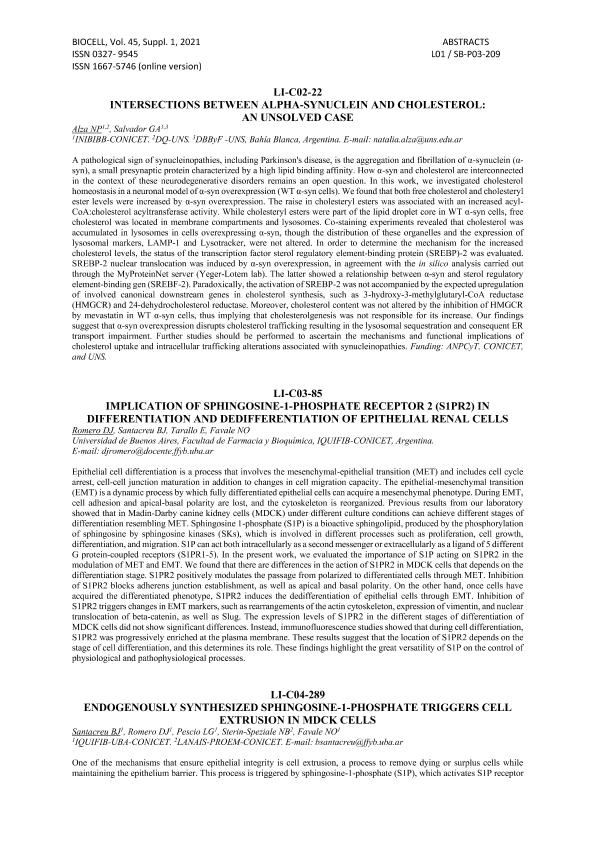Mostrar el registro sencillo del ítem
dc.contributor.author
Romero, Daniela Judith

dc.contributor.author
Santacreu, Bruno Jaime

dc.contributor.author
Tarallo, Estefania

dc.contributor.author
Favale, Nicolas Octavio

dc.date.available
2022-10-17T15:32:36Z
dc.date.issued
2021
dc.identifier.citation
Implication of Sphingosine-1-Phosphate Receptor 2 (S1PR2) in Differentiation and Dedifferentiation of Epithelial Renal Cells; LVI Annual Meeting Argentine Society for Biochemistry and Molecular Biology; XV Annual Meeting Argentinean Society for General Microbiology; Argentina; 2020; 1-1
dc.identifier.issn
0327-9545
dc.identifier.uri
http://hdl.handle.net/11336/173528
dc.description.abstract
Epithelial cell differentiation is a process that involves the mesenchymal-epithelial transition (MET) and includes cell cycle arrest, cell-cell junction maturation in addition to changes in cell migration capacity. The epithelial-mesenchymal transition (EMT) is a dynamic process by which fully differentiated epithelial cells can acquire a mesenchymal phenotype. During EMT, cell adhesion and apical-basal polarity are lost, and the cytoskeleton is reorganized. Previous results from our laboratory showed that in Madin-Darby canine kidney cells (MDCK) under different culture conditions can achieve different stages of differentiation resembling MET. Sphingosine 1-phosphate (S1P) is a bioactive sphingolipid, produced by the phosphorylation of sphingosine by sphingosine kinases (SKs), which is involved in different processes such as proliferation, cell growth, differentiation, and migration. S1P can act both intracellularly as a second messenger or extracellularly as a ligand of 5 different G protein-coupled receptors (S1PR1-5). In the present work, we evaluated the importance of S1P acting on S1PR2 in the modulation of MET and EMT. We found that there are differences in the action of S1PR2 in MDCK cells that depends on the differentiation stage. S1PR2 positively modulates the passage from polarized to differentiated cells through MET. Inhibition of S1PR2 blocks adherens junction establishment, as well as apical and basal polarity. On the other hand, once cells have acquired the differentiated phenotype, S1PR2 induces the dedifferentiation of epithelial cells through EMT. Inhibition of S1PR2 triggers changes in EMT markers, such as rearrangements of the actin cytoskeleton, expression of vimentin, and nuclear translocation of beta-catenin, as well as Slug. The expression levels of S1PR2 in the different stages of differentiation of MDCK cells did not show significant differences. Instead, immunofluorescence studies showed that during cell differentiation, S1PR2 was progressively enriched at the plasma membrane. These results suggest that the location of S1PR2 depends on the stage of cell differentiation, and this determines its role. These findings highlight the great versatility of S1P on the control of physiological and pathophysiological processes.
dc.format
application/pdf
dc.language.iso
eng
dc.publisher
Tech Science Press

dc.rights
info:eu-repo/semantics/openAccess
dc.rights.uri
https://creativecommons.org/licenses/by-nc-sa/2.5/ar/
dc.subject
EPITHELIAL-MESENCHYMAL TRANSITION
dc.subject
SPHINGOSINE-1-PHOSPHATE RECEPTOR 2
dc.subject
SPHINGOSINE 1-PHOSPHATE
dc.subject
EPITHELIAL RENAL CELLS
dc.subject.classification
Bioquímica y Biología Molecular

dc.subject.classification
Ciencias Biológicas

dc.subject.classification
CIENCIAS NATURALES Y EXACTAS

dc.title
Implication of Sphingosine-1-Phosphate Receptor 2 (S1PR2) in Differentiation and Dedifferentiation of Epithelial Renal Cells
dc.type
info:eu-repo/semantics/publishedVersion
dc.type
info:eu-repo/semantics/conferenceObject
dc.type
info:ar-repo/semantics/documento de conferencia
dc.date.updated
2022-09-22T11:45:46Z
dc.journal.pagination
1-1
dc.journal.pais
Argentina

dc.journal.ciudad
Mendoza
dc.description.fil
Fil: Romero, Daniela Judith. Consejo Nacional de Investigaciones Científicas y Técnicas. Oficina de Coordinación Administrativa Houssay. Instituto de Química y Físico-Química Biológicas "Prof. Alejandro C. Paladini". Universidad de Buenos Aires. Facultad de Farmacia y Bioquímica. Instituto de Química y Físico-Química Biológicas; Argentina
dc.description.fil
Fil: Santacreu, Bruno Jaime. Consejo Nacional de Investigaciones Científicas y Técnicas. Oficina de Coordinación Administrativa Houssay. Instituto de Química y Físico-Química Biológicas "Prof. Alejandro C. Paladini". Universidad de Buenos Aires. Facultad de Farmacia y Bioquímica. Instituto de Química y Físico-Química Biológicas; Argentina
dc.description.fil
Fil: Tarallo, Estefania. Consejo Nacional de Investigaciones Científicas y Técnicas. Oficina de Coordinación Administrativa Houssay. Instituto de Química y Físico-Química Biológicas "Prof. Alejandro C. Paladini". Universidad de Buenos Aires. Facultad de Farmacia y Bioquímica. Instituto de Química y Físico-Química Biológicas; Argentina
dc.description.fil
Fil: Favale, Nicolas Octavio. Consejo Nacional de Investigaciones Científicas y Técnicas. Oficina de Coordinación Administrativa Houssay. Instituto de Química y Físico-Química Biológicas "Prof. Alejandro C. Paladini". Universidad de Buenos Aires. Facultad de Farmacia y Bioquímica. Instituto de Química y Físico-Química Biológicas; Argentina
dc.relation.alternativeid
info:eu-repo/semantics/altIdentifier/url/http://www.samige.org.ar/admin/news/files/170-TSP_BIOCELL_42376.pdf
dc.conicet.rol
Autor

dc.conicet.rol
Autor

dc.conicet.rol
Autor

dc.conicet.rol
Autor

dc.coverage
Nacional
dc.type.subtype
Reunión
dc.description.nombreEvento
LVI Annual Meeting Argentine Society for Biochemistry and Molecular Biology; XV Annual Meeting Argentinean Society for General Microbiology
dc.date.evento
2020-11
dc.description.paisEvento
Argentina

dc.type.publicacion
Journal
dc.description.institucionOrganizadora
Sociedad Argentina de Investigación Bioquímica y Biología Molecular
dc.source.revista
Biocell

dc.type
Reunión
Archivos asociados
